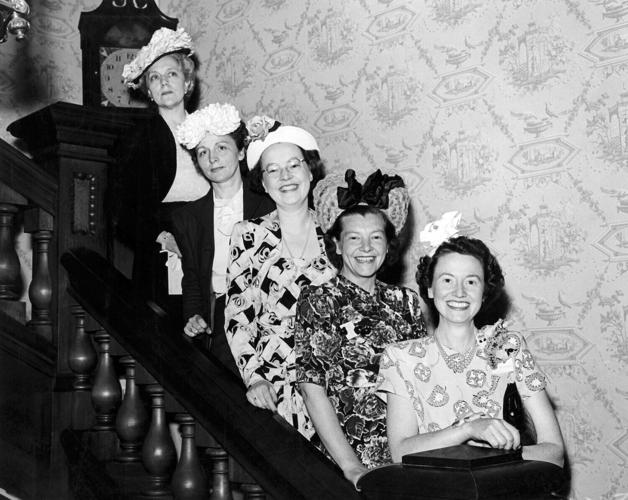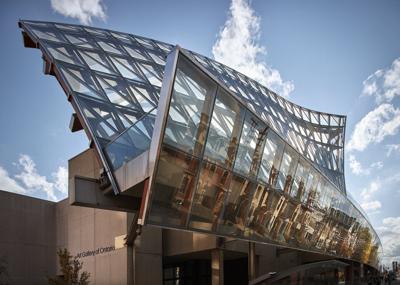
Director and CEO Stephan Jost leads columnist Shinan Govani on a tour of the Art Gallery of Ontario.
Shinan GovaniWalking and talking.
That was the plan of attack, and the fait accompli, at the Art Gallery of Ontario when I wandered over last week to meet its director.
“My husband always says I beat him,” Stephan Jost laughed at one point when the convo turned to the “steps” he usually completes in a day in the gallery spanning 45,000 square metres and encompassing over 120,000 works.
The art of the meander. But also the Tao of looking.
It being mere days before the AGO would fete its 125th anniversary with an expansive party — complete with “digital confetti” — he was looping back, but also sprinting ahead.
“I couldn’t put my finger on the AGO when I joined nine years ago,” Jost began to say, as we were zeroing in on Jacopo Tintoretto’s famous “Christ Washing His Disciples’ Feet” painting one moment, taking in an exquisite Inuit stick-figure another. Because unlike other institutions “we don’t have a strong founding narrative.”
“Most people don’t know who Harriet Boulton Smith was. She gave us the Grange (which became foundational to the gallery early on) and the Grange Park (behind the gallery). Most do not know it is a private park (managed by the city).”

The front of what was then Art Gallery of ������������in the 1950s.
AGOOriginally called Art Museum of Toronto, and founded in July of 1900, the gallery’s first purchase was “The Captive Butterfly” by Edward Atkinson Hornel. Funded by 31 private subscribers, it cost $610. “A colonial house, a beaux-art building,” Jost described. Commandeered by Sir Edmund Walker (whose name still adorns the main lobby court) — “he was Bank of Commerce, which we know as CIBC now.”
Things tread along until the Grange, indeed, which set a new course for the gallery. Admission then? 25 cents.
1920: The Group of Seven holds their first exhibition at the AGO. 1924: a plan to substantially expand the space moves ahead, c/o private citizens raising $280,000 ($5 million today). 1926: the opening of the Sir Edmund Walker Memorial Court and adjoining spaces.

Visitors on the last day of the 1964 exhibit “Picasso and Man” at what was then the Art Museum of Toronto, now the Art Gallery of Ontario.
AGO1964! Boom! Arguably Canada’s first blockbuster exhibition: a first-ever retrospective of Pablo Picasso, visited then by a staggering 107,214 visitors. Renamed the Art Gallery of Ontario in 1966, the ensuing years brought the opening of the Henry Moore Sculpture Centre, the world’s largest public collection of Moore’s artworks outside of the U.K.
“Wrapping.” A word that jigged from the director’s mouth more than once. Unlike other institutions that built adjacent additions or expanded outwards, the AGO is a Russian doll of sorts. “So in the ’90s we wrapped it again with postmodern, and then (Frank) Gehry wrapped it again” — when the newest glass dazzle happened in the aughts.
In a departure, however, the newest addition, underway now — the much-anticipated Dani Reiss Modern and Contemporary Gallery — is rising as its own creature.
With kid-on-Christmas-morning bounce, Jost later took me to a back stairwell from which if you tippytoe (at least I had to tippytoe), you can catch the skeleton of the new edifice. Most assuredly coming along! A $100-million project, led by architect Annabelle Selldorf (who also led the recent restoration of the Frick in Manhattan, in a joint effort between Selldorf Architects, Diamond Schmitt and Two Row Architects). It will have a “bridge at the top,” Jost said, connecting the two buildings. Slated for 2027.
“Internally, we have started calling it to the DRMC,” he also mentioned. “It’s funny how names sometimes catch on.”
Take note, T.O.

The Royal Canadian Academy of Arts’ 41st annual exhibition at the Art Museum of ������������in 1919.
AGOWhat I wasn’t perhaps fully prepared for is how much of our walk-and-talk would turn out to be a remembrance of social Toronto. As Jost clocked the various names that adorn a ribbon of gallery spaces, it was a reconnect with so many of the legends of the city, like the late mogul Ken Thomson (by far the number one largest patron in the AGO’s history), but also lesser known names like Sam Samuel and Esther Sarick. A roll-call, indeed, of Latners, Iveys and Greens. The collection that Phil Lind left behind, and generational benevolence, as in the case of the Jackman clan (in the family’s latest wave of support, those three power-sister Jackmans, Victoria, Consuelo and Trinity, will unite as co-chairs of Art Bash come September, the AGO’s signature gala).

The women’s committee of the ������������Museum of Art, founded in 1945 by Lady Kemp, top, with Mrs. J.G. Godsoe, Mrs. J.G. Edison, Mrs. Geo. Hendrie and Mrs. G.A. Adamson on the stairs of the Grange in 1947.
AGOAnd then there is “Lady Kemp,” a prescient ������������figure (supporting Helen Keller and other blindness causes), whose art legacy came into fuller view when Jost and I walked into a room burnishing a solemn Rothko. No. 1, White and Red. Seven by eight feet. Purchased for $22,000 (U.S.).
It is here at all because of the so-called “Women’s Committee,” founded in 1945 by Kemp, basically to promote gallery membership and boost fundraising. “Prescient” is the word that gets thrown a lot when it comes to her gang — art patrons, who for five-plus decades, supported the AGO in acquiring numerous contemporary artworks, including Andy Warhol’s “Elvis I and II” (1963/64).
As the story goes: in 1962, the then-director of the gallery, William Withrow, travelled with a curator to meet Rothko (then still in the elemental stages of his notoriety). That is when the deal was sealed, supported unanimously by Kemp et al.
If these walls would talk! “All this support,” Jost impressed, “it’s not abstract to us. It lives on.”
Asked if he is still discovering pieces, he gave me a duh. “I love that sense of not being able to know everything, see everything” he said.
One hundred and 25 years young.




































To join the conversation set a first and last name in your user profile.
Sign in or register for free to join the Conversation